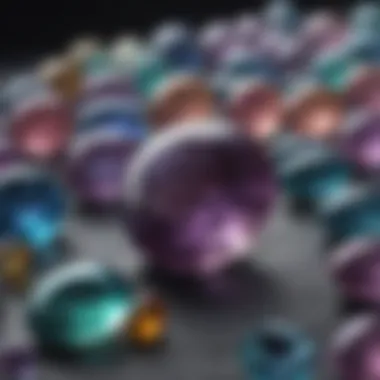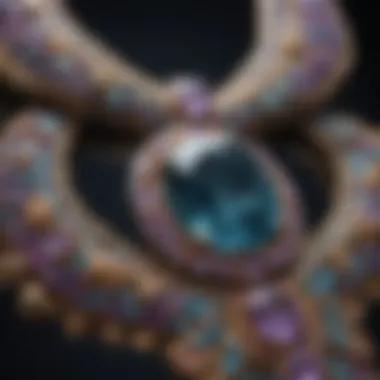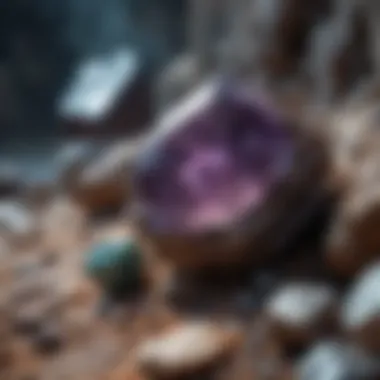Understanding Alexandrite Cabochons: A Comprehensive Guide


Intro
Alexandrite cabochons represent a unique category of gemstones, distinguished by their captivating color-changing abilities. This guide unveils the intricacies surrounding these stones, providing insights into their origins, identification methods, and adapatability in jewelry. Understanding the significance of alexandrite cabochons extends not only to aesthetic appreciation but also to their geological and historical contexts.
History and Origins
Geological Formation
Alexandrite forms under specific geological conditions. Originally discovered in the Ural Mountains of Russia, this gemstone is a variety of chrysoberyl. The unique color change from green in daylight to red in incandescent light is due to the presence of chromium within its crystal structure. The rarity of alexandrite cabochons stems from these precise conditions, making it a sought-after piece among collectors.
Historical Significance and Cultural Impact
Alexandrite holds a rich history, dating back to the 19th century. Named after Tsar Alexander II of Russia, it symbolizes balance and metamorphosis. In various cultures, alexandrite is associated with wealth and prosperity. Its sudden disappearance from the Russian market created a demand surge, further elevating its status as a coveted gem.
Identification and Classification
Identifying Alexandrite Cabochons
Identifying a genuine alexandrite cabochon requires attention to certain characteristics:
- Color Change: The most critical attribute to observe is the distinct color shift. Genuine stones exhibit a noticeable transition from greenish hues to reddish tones.
- Clarity and Imperfections: While many gemstones may have inclusions, alexandrites should possess minimal imperfections. Crystals with high clarity command higher prices.
- Hardness: The expected hardness level is between 8.5 on the Mohs scale, which provides resilience.
Common Types and Variations
While alexandrite cabochons share remarkable traits, several variations exist:
- Natural Alexandrite: Formed through natural processes, these cabochons are invaluable.
- Synthetic Alexandrite: Created in labs, these stones can mimic natural variations and are often less expensive.
- Consult Gemological Institute Europe: For serious collectors, getting stones certified can ensure authenticity and understanding of their value.
"Alexandrite is not just a stone; it is a potential investment, carrying both historical and aesthetic value."
These insights provide a backdrop for understanding the market trends and care that follow through. Recognizing the uniqueness of alexandrite cabochons can enrich the experience of both collectors and enthusiasts.
Prelims to Alexandrite Cabochons
The topic of alexandrite cabochons is significant for various reasons. Alexandrite itself is a gemstone that possesses unique qualities. These include its ability to change color based on lighting conditions, which captivates collectors and gem enthusiasts alike. Cabochons, characterized by their polished, rounded shapes, highlight the stone's natural beauty while allowing its rich colors to be displayed prominently.
Definition of Alexandrite Cabochon
An alexandrite cabochon is a polished piece of the alexandrite gemstone, typically shaped into a smooth, rounded profile. Unlike faceted stones, cabochons are not cut with sharp edges to reflect light. Instead, the cabochon technique enhances the stone's natural colors and luster, emphasizing its unique optical properties. When light interacts with the slightly curved surface, it presents a vibrant play of colors, reminding one of the gem's dual nature.
Historical Background
The history of alexandrite cabochons is tied closely to the discovery of alexandrite itself. First identified in the Ural Mountains of Russia in the early 19th century, the gemstone gained prominence due to its striking color-change phenomenon. Initially named after Tsar Alexander II, alexandrite became associated with Russian royalty. Over time, its rarity and distinctive traits captured the interest of jewelers and collectors worldwide.
As the supply of Russian alexandrite diminished, new sources emerged in Brazil and Sri Lanka. These discoveries led to variations in quality and color, further enriching the lore surrounding alexandrite. Cabochons became particularly popular for their ability to showcase the richness of color display, acting as both ornamental pieces and meaningful artifacts. Today, collectors appreciate not only the beauty but also the historical significance of alexandrite cabochons, making them a valued addition to any gem collection.
Geological Characteristics of Alexandrite
The geological characteristics of alexandrite are critical to understanding its formation, quality, and value. This section will explore the essential aspects of alexandrite's chemical makeup, its unique color-changing abilities, and the factors that influence its clarity and cut. Recognizing these elements not only enhances appreciation for this rare gem but also informs collectors about what to look for when choosing alexandrite cabochons.
Chemical Composition
Alexandrite belongs to the chrysoberyl family of gemstones. Its chemical formula is BeAl2O4, indicating it is composed of beryllium, aluminum, and oxygen. However, the defining feature that sets alexandrite apart is the presence of chromium ions within its structure. These chromium ions are what impart its distinctive color-changing properties. When viewed in daylight, alexandrite typically appears greenish or bluish-green, while it transforms to a reddish or purplish hue under incandescent light. This duality in color is not just visually striking; it is a key factor affecting the value of the stone.


Understanding the composition also helps in distinguishing genuine alexandrite from imitations that may be chemically similar but lack the unique optical properties. For instance, synthetic versions or treated stones may not display the same intense color shifts. Therefore, knowledge of the chemical composition is valuable for collectors.
Color-Changing Properties
The color-changing phenomenon of alexandrite is one of nature's fascinating optical effects. The richness of color arises from the way light interacts with the chromium ions in the stone. The gem exhibits a phenomenon known as pleochroism, meaning it shows different colors when viewed from different angles. This adds to the depth of its appearance and increases its allure.
The specific colors can vary based on the lighting conditions, with daylight inducing a cooler range of hues and incandescent light producing warmer tones. The intensity of the color change can also depend on factors like light quality and the angle of observation. For collectors, a more pronounced color shift can signify greater value and desirability.
"The color change in alexandrite is not merely a curiosity; it is a testament to the unique conditions under which this stone forms."
Clarity and Cut
Clarity plays a significant role in determining the worth of an alexandrite cabochon. Like all gemstones, fewer inclusions typically translate to higher value. Alexandrite can contain inclusions due to its formation process, and these inclusions may affect transparency and brilliance. Examining a stone under magnification can reveal qualities that influence its overall appeal.
Additionally, the cut of the cabochon can affect how light interacts with the stone, impacting its visual quality. Cabochon-cut alexandrite is typically smooth and dome-shaped, which allows for maximum light reflection, enhancing the depth of color. Craftsmanship in cutting can also affect how well the color-changing properties are displayed.
The Process of Creating Cabochons
Creating alexandrite cabochons is a meticulous process that enhances the natural beauty of this unique gemstone. Understanding this process is essential for collectors and enthusiasts alike. The transformation from rough stone into a polished cabochon involves several steps that require skill and precision. This journey is not merely about aesthetics; it also significantly impacts the stone's value and appeal in various applications.
From Rough Stone to Cabochon
The transition from rough alexandrite to a finished cabochon is significant. Initially, the raw form of alexandrite is unearthed, often containing imperfections that require careful analysis. Each rough stone has its own characteristics and potential. Assessing these attributes gives insight into the most suitable cutting style and shape for the final product.
Once the suitable rough is selected, the cutting process begins. This step entails removing excess material while protecting the integrity of the stone. By focusing on maximizing the color play and overall appeal, artisans can reveal the captivating depth and rich hues inherent to alexandrite.
Cutting Techniques
Different cutting techniques can be applied when creating cabochons. The choice of technique has a substantial influence on the final appearance. Traditional cabochon cutting allows the gem to showcase its unique color changes effectively. This technique gives the gem a smooth, rounded shape that enhances light reflection. There are several important cutting styles to consider:
- Standard Cabochon Cutting: Simple, oval or round shapes are cut, allowing for smooth surfaces that highlight color.
- Designer Cabochon Cutting: Includes more complex shapes that can emphasize certain facets of the stone's color.
Cutting demands not only precision but also an understanding of the mineral's properties. Alexandrite's unique color-changing qualities necessitate skill to ensure the final cut enables the stone to achieve its full chromatic potential.
Polishing Techniques
Polishing is the final touch that brings out the best in alexandrite cabochons. Without proper polishing, even the finest cuts can appear dull. The goal is to achieve a high shine that plays well with light.
A few common polishing techniques include:
- Grading with Grit: Stones are polished using varying grits to refine the surface progressively. Starting with coarse grit and moving to finer is standard.
- Buffing Wheels: These are used to create a high-gloss finish by applying gentle pressure and consistent motion.
Polishing improves visual appeal and protects the stone from scratches and environmental damage. Additionally, the choice of polishing compound can further influence the final outcome. Selecting a compound that complements the unique properties of alexandrite is critical.
The process of cutting and polishing alexandrite cabochons transforms the raw mineral into captivating pieces, maximizing the stone's natural beauty and enhancing its value.
Applications of Alexandrite Cabochons
Alexandrite cabochons serve a range of unique applications due to their remarkable properties and desirability. Understanding these applications sheds light on the relevance of alexandrite in both the jewelry industry and the collector's market. The utility of these stones reaches beyond mere aesthetics, impacting design principles, investment value, and appreciation among enthusiasts.
Jewelry Design
One of the primary applications of alexandrite cabochons is within the field of jewelry design. The captivating color-changing properties of alexandrite—shifting from green in daylight to a purplish red under incandescent light—make it an ideal choice for artists and designers who aim to create pieces that stimulate engagement. Cabochons, in particular, are favored for their smooth, rounded surfaces that highlight the gemstone's vibrant colors without the interruption of facets. This unique cut allows the wearer to experience the full effect of the stone’s optical qualities.


Benefits of using alexandrite cabochons in jewelry include:
- Durability: Alexandrite ranks 8.5 on the Mohs scale, making it a suitable option for daily wear.
- Versatility: The subtle yet striking color transitions lend themselves to various styles, from classic to contemporary.
- Collectability: Jewelry pieces featuring alexandrite cabochons often become sought-after items, increasing their value over time.
Considerations in jewelry design include understanding the best settings that maximize the stone's color change and clarity. Designers must also be thoughtful in pairing alexandrite with different metals or complementary gemstones to enhance its visual appeal. The unique characteristics of alexandrite make it not just a choice, but an opportunity to express craftsmanship and artistry.
Collector's Items
In addition to their role in jewelry, alexandrite cabochons hold significant value as collector's items. These stones are rare, and their allure is augmented by the fascinating stories surrounding their origins. Collectors often appreciate the historical significance of alexandrite, particularly its discovery in the Ural Mountains of Russia during the 19th century. The limited availability of high-quality alexandrite further contributes to its desirability.
Factors influencing the collector's market include:
- Provenance: The history or origin of the stone can significantly affect its market value.
- Quality: Features like clarity, color depth, and size play crucial roles; exceptional specimens can command impressive prices.
- Certification: Authenticity reports from reputable gemological institutions add confidence in a purchase and can enhance resale value.
Collectors often build their collections not just for personal enjoyment but also as a form of investment. The rarity and beauty of alexandrite cabochons can result in substantial financial returns if sold at the right moment or within the right market conditions.
Overall, the significance of alexandrite cabochons should not be underestimated. Their beauty, combined with their investment potential, makes them a compelling choice for both designers and collectors alike.
Market Trends and Valuation
Understanding the market trends and valuation of alexandrite cabochons is essential for collectors and enthusiasts alike. This section emphasizes the significance of these aspects in comprehending the true worth of alexandrite cabochons. Given their rarity, these gemstones can fluctuate in value based on multiple factors, making it critical for buyers and sellers to stay informed.
Market trends portray the evolving landscape of alexandrite cabochons. With the rise of social media awareness, many potential buyers are now looking for these exquisite stones, driving demand. This rising popularity can enhance the market value significantly. Furthermore, as the unique color-changing properties of alexandrite stones gain recognition in the market, we can observe a trend toward increased valuations.
Valuation, on the other hand, involves different metrics. This includes the stone's quality, the craftsmanship of the cabochon, and market dynamics at play. Understanding these elements can empower both buyers and sellers to negotiate effectively in the marketplace.
Current Market Value
As of today, the current market value of alexandrite cabochons varies widely. Generally, well-cut, high-quality stones can reach prices ranging from several thousand to even tens of thousands of dollars. This valuation is highly dependent on factors such as size, clarity, and the intensity of the color change. Bigger stones with exceptional quality can command incredibly high prices, especially in custom jewelry.
Several online sources and gemstone retailers provide insights into the current value trends, but it is advisable to consult certified gemologists to assess the precise worth accurately.
Factors Influencing Price
Multiple factors affect the price of alexandrite cabochons:
- Color Quality: The more vivid and deeper the color, the higher the value. Alexandrite exhibits a shift from green to red, and a distinct display of both colors is highly coveted.
- Clarity: Stones without visible inclusions hold more value. High clarity ensures better light refraction, enhancing the stone's appeal.
- Size: Larger cabochons tend to be more valuable. However, a high-quality small stone can be worth more than a larger, poorer quality one.
- Origin: The geographic origin also impacts value, as some locations are renowned for producing high-quality alexandrite. Stones from Brazil, Sri Lanka, or Russia may see different valuations based on their origin.
- Market Demand: Fluctuations in consumer interest and demand can drive prices up or down. Awareness campaigns that promote the uniqueness of these gemstones can influence market trends.
Understanding these factors can assist collectors in making informed purchases and sales. Keeping an eye on market shifts and consulting with experts ensure favorable transactions.
Caring for Alexandrite Cabochons
Caring for alexandrite cabochons is crucial for preserving their beauty and ensuring their longevity. These gemstones are not only prized for their unique color-changing properties but also for their historical and aesthetic significance. Proper care enhances their visual appeal and maintains their market value. Neglect can easily lead to scratches, dullness, or even irreversible damage, which diminishes both their beauty and worth. This section outlines essential cleaning methods and storage recommendations that collectors should embrace for their alexandrite cabochons.
Cleaning Methods
Cleaning alexandrite cabochons requires careful attention to materials and techniques to avoid damage. Avoid harsh chemicals or abrasive materials. Instead, opt for gentler options. Here are a few effective cleaning methods:
- Mild Soapy Water: Mix a few drops of a gentle dish soap with warm water. Soak the cabochon briefly, then use a soft cloth or a soft toothbrush to gently scrub the surface. Rinse thoroughly with clean water to remove any soap residue.
- Ultrasonic Cleaners: While effective for some gemstones, these devices should be used with caution. Assess the stability of the cabochon before using. If in doubt, stick to manual cleaning methods.
- Steam Cleaning: This method can be suitable for cabochons, but it is always better to consult a professional gemologist first. Steam can help remove dirt without using chemicals.
Remember, never use vinegar or chemical cleaners, as they can discolor or damage the surface of the stone. Dry the cabochon softly with a clean, lint-free cloth to prevent water spots.
Storage Recommendations


Proper storage conditions are imperative for preserving the integrity of alexandrite cabochons. Here are specific recommendations to consider:
- Ideal Environment: Store cabochons in a cool, dry place away from direct sunlight. Excessive heat or humidity can cause damage or dullness over time.
- Individual Compartments: Utilize soft pouches or individual compartments in jewelry boxes to prevent scratching and chipping. Avoid placing multiple stones together as they can rub against each other and cause harm.
- Avoid Exposure: Regularly Check the storage environment to ensure minimal exposure to extreme conditions. Using silica gel packs can also help in maintaining humidity levels.
- Proper Handling: When handling the cabochons, ensure hands are clean and dry. Avoid touching the stone surface with bare fingers to prevent oils and dirt residue.
"Proper care practices greatly enhance the aesthetic and monetary value of alexandrite cabochons, making them more appealing to collectors and enthusiasts."
By implementing these cleaning methods and storage recommendations, owners can maintain the allure and integrity of their alexandrite cabochons. Such diligence not only sustains their physical properties but also protects their investment in this captivating gemstone.
Authenticity and Certification
In the realm of gemstones, authenticity and certification play a crucial role in determining the value and trustworthiness of a stone. For alexandrite cabochons, which are particularly rare and carry a premium price, verifying authenticity is essential. The unique nature of alexandrite, known primarily for its color-changing abilities, makes it a target for imitation. Therefore, a comprehensive understanding of the authenticity of alexandrite cabochons is indispensable for collectors and enthusiasts alike.
One major benefit of establishing authenticity involves the assurance of investment. When purchasing alexandrite, buyers want to feel confident that they are receiving a genuine product. An authentic cabochon not only holds aesthetic appeal but also possesses intrinsic value. This is especially significant in the luxury market, where resale value can fluctuate based on authenticity.
Furthermore, considering the implications of certification can prevent financial loss incurred from counterfeit stones. Relying on professionals and organizations that are recognized in the field can offer peace of mind and protect against common pitfalls in the gemstone market.
Identifying Genuine Alexandrite
Identifying genuine alexandrite can be accomplished through several methods. Experienced gemologists typically use tools such as spectroscopes and refractometers to analyze a stone's attributes. These tools help in determining the unique properties of alexandrite that separate it from simulants or other chrysoberyl varieties.
Some signs indicating authenticity include:
- Color Change: Genuine alexandrite exhibits a distinct color shift from green in daylight to reddish in incandescent light.
- Inclusions: Authentic stones may show slight inclusions that can be viewed under magnification. Overly perfect stones might arouse suspicion.
- Hardness: Alexandrite ranks 8.5 on the Mohs scale, allowing it to withstand everyday wear, unlike softer imitations.
It’s important to note that while the naked eye can identify some attributes, professional evaluation is recommended for confirmation.
Certification Bodies and Reports
Certification bodies provide reports that are vital in establishing the authenticity of alexandrite cabochons. Institutions such as the Gemological Institute of America (GIA) and the International Gemological Institute (IGI) are highly regarded. They utilize sophisticated tools and perform comprehensive examinations to verify the legitimacy of gemstones.
A certification report often includes several key elements:
- Details about the stone: Report specifies whether it is natural or synthetic, along with its origins and any treatments it may have undergone.
- Grading: The report will assess the quality based on color, clarity, cut, and carat weight.
- Photographs: Visuals accompany reports, showing the gemstone from various angles for better identification.
Utilizing reports from reputable certification bodies can significantly enhance the buyer's confidence in their acquisition. It serves as a formal document verifying the stone's characteristics and authenticity, ensuring that both collectors and connoisseurs make informed decisions.
Always seek certification when purchasing alexandrite cabochons. It can safeguard both investments and ensure the acquisition of genuine stones.
Finale
The conclusion serves as the final point of reflection on the fascinating subject of alexandrite cabochons. This section is significant as it encapsulates the key insights discussed throughout the article. It allows readers to appreciate the unique attributes of these cabochons while considering their implications for collectors and enthusiasts.
Understanding the geological and historical context of alexandrite cabochons can enhance their value and appeal. The importance of this conclusion goes beyond mere recapitulation; it also emphasizes the attraction of alexandrite as a collectible item and its broader relevance in the gemstone market.
Summation of Key Points
- Alexandrite cabochons are renowned for their unique color-changing properties, moving from greenish-blue in daylight to purplish-red under incandescent light.
- The historical background showcases alexandrite's rarity and its discovery in the 19th Century, linking it to Russian royalty and significant cultural events.
- The geological characteristics, including its chemical makeup, contribute significantly to its appeal and market value.
- Understanding the cutting and polishing techniques enhances buyers' appreciation for the craftsmanship involved in creating these cabochons.
- Market trends show a rising demand for alexandrite cabochons, making them a worthy investment.
- Proper care and storage methods are critical to preserving these valuable stones for future generations.
Future Trends in Alexandrite Cabochons
The future for alexandrite cabochons looks promising. As the demand for these rare gemstones increases, several trends are emerging. First, new markets are opening, particularly in Asia, where gemstone collecting is gaining popularity.
In addition, advancements in synthetic gem production can lead to better methods of creating high-quality lab-grown alexandrite. This development may affect market prices but can also provide collectors with more options.
Moreover, the rise of online platforms for buying and selling gemstones facilitates accessibility for collectors. This trend enhances the potential for education about alexandrite's properties, thereby attracting new enthusiasts.
Key considerations for the future include:
- Awareness and Education: Greater efforts in educating potential buyers about the distinct characteristics of alexandrite cabochons can boost interest.
- Sustainability: The shift towards ethical mining and sourcing practices is expected, aligning with broader trends in consumer behavior.
- Technological Integration: Innovations in technology will likely provide enhanced methods for verifying authenticity and appraising value.



